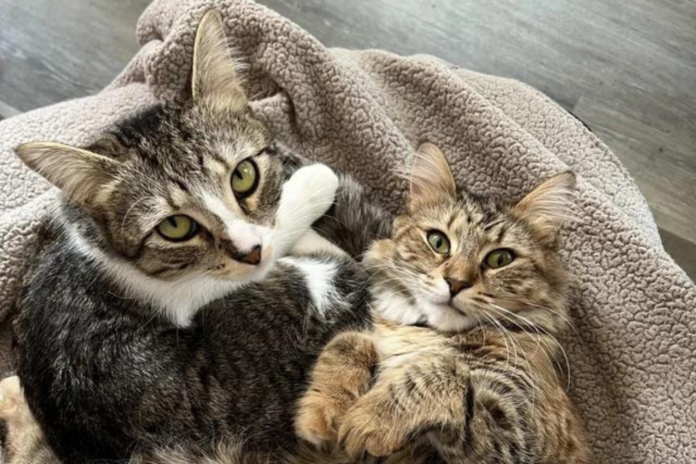A pair of cats have taken the internet by storm after their owner queried why the two felines who are from the same litter look so completely different.
River and Elsa live in Pennsylvania with the owner Dylan, who posted a picture of them on Reddit’s r/cats subreddit where he asked: “Why do my cats from the same litter look so different?”
Owner Dylan told Newsweek: “I know they’re from the same litter because only one mother could have been possible.”
The post has gained over 6,000 upvotes and hundreds of comments as people shared their thoughts and theories.
Dylan
“Genetics and stuff?” suggested one Reddit user unhelpfully in the comments. “I basically almost failed chem and bio, so that’s all I can contribute.”
A similar expert in biology wrote: “The joys of mix-and-match genetics!”
Another shared a similar experience as the original poster: “My cat was the sole one in her litter to be way different. The other six cats were all black or tuxedo shorthairs with yellow or orange eyes, while she’s a longhair calico with green eyes.”
While other theories got a little more wild. One reply said: “Cat nurse swapped cat babies at the cat clinic.”
Another joked: “When they were kittens, I replaced one with a fake.”
Commenting on the infamous independence of felines, one Redditor posted: “Cats don’t even obey their own DNA.”
Why Do Two Cats From the Same Litter Look Different?
It is most likely that the reason behind River and Elsa’s differing looks are down to something called “heteropaternal superfecundation.”
This occurs when a female cat is impregnated by more than one male during a single ovulation period, resulting in kittens in the same litter with differing genetic makeups.
This phenomenon is not unique to cats and has been reported in other mammals as well, including dogs, cows, and even humans. Just like fraternal twins in humans, these kittens will inherit different sets of genes from their respective fathers, leading to variations in their physical traits.
While heteropaternal superfecundation is rare in humans, it is not uncommon in cats. Cat populations, especially in urban areas, can exhibit a higher rate of multiple paternity.
The unique reproductive characteristics of felines, being “seasonally polyestrous,” meaning they have multiple reproductive cycles during the breeding season, contribute to the commonality of this phenomenon, making superfecundation almost inevitable in cats.
In hundreds of comments people shared their thoughts and own experiences of different cats in the same litter. From a ginger tabby and black cat to a black and white cat with a tortoiseshell sibling.
While different fathers are the likely answer to the cat’s differing appearances, it is possible for cats with the same two parents to display stark differences in appearance. An intricate combination of dominant and recessive genes in cats allows for a variety of outcomes when it comes to fur color and pattern.
The genes responsible for a cat’s fur color are located on the X chromosome, which means that male kittens get their coat color from their mom, while female kittens inherit these genes from both parents. The orange gene (O) and the black gene (B) are responsible for the two primary colors in cats, and their variations can lead to a range of coat colors, such as chocolate or cinnamon.
Do you have funny and adorable videos or pictures of your pet you want to share? Send them to [email protected] with some details about your best friend and they could appear in our Pet of the Week lineup.
Uncommon Knowledge
Newsweek is committed to challenging conventional wisdom and finding connections in the search for common ground.
Newsweek is committed to challenging conventional wisdom and finding connections in the search for common ground.


